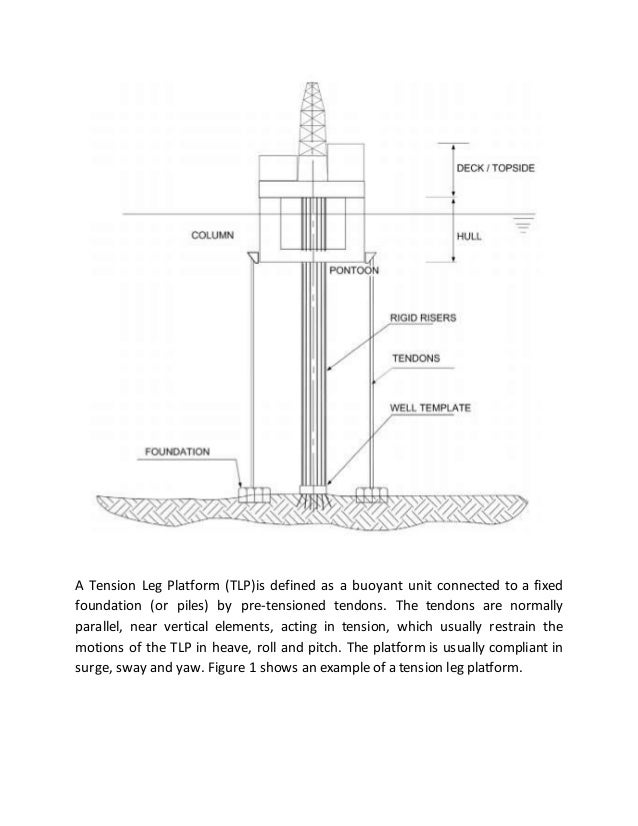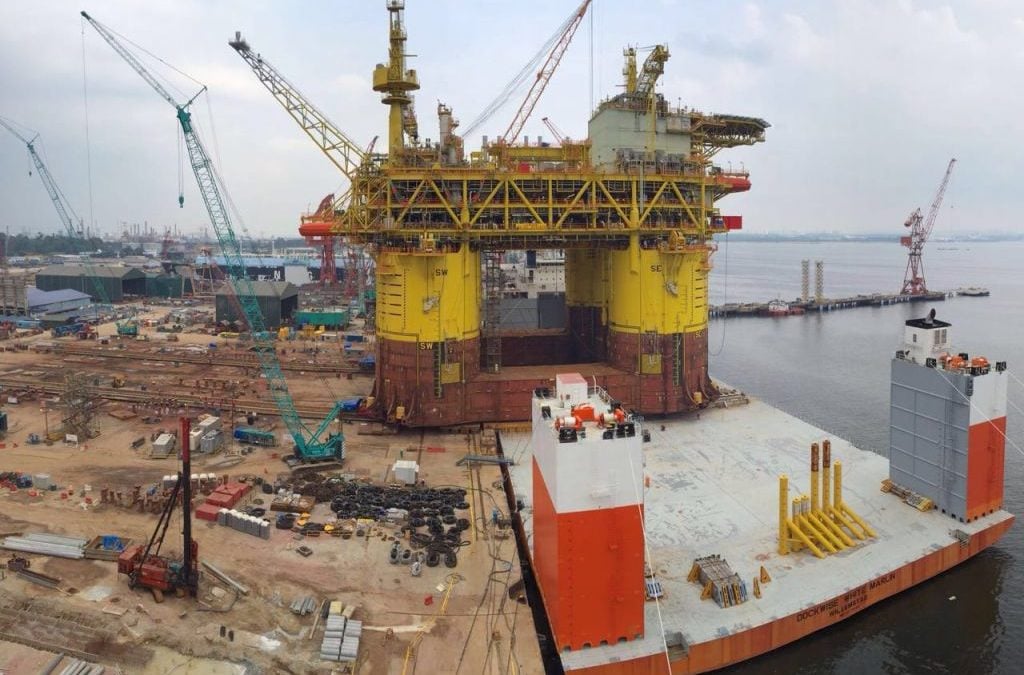Schematic representation of tension leg platform Download Scientific Diagram

Tension Leg Platform technology preserves many of the operational advantages of a fixed platform while reducing the cost of production in water depths up to about 4900 ft or 1500 m. Its production and maintenance operations are similar to those of fixed platforms. However, TLPs are weight sensitive and may have limitations on accommodating.
Magnolia Tension Leg Platform MDR
The complete paper is a comprehensive discussion of the development and deployment of the tension leg platform (TLP), one of the four major platform types that also include floating production, storage, and offloading (FPSO) vessels; semisubmersible floating production systems; and spar platforms. August 31, 2020.
Tension leg platform hydrodynamic added mass coefficients [17] Download Scientific Diagram

This article, written by JPT Technology Editor Chris Carpenter, contains highlights of paper OTC 30752, "The Tension Leg Platform: From Hutton to Big Foot," by Steven J. Leverette, Leverette Offshore, and Stephen B. Hodges, Shell (Retired), prepared for the 2020 Offshore Technology Conference, originally scheduled to be held in Houston, 4-7 May. The paper has not been peer reviewed.
Ursa Tension Leg Platform

The relative advantages and disadvantages of the platform types with the design challenges are discussed. The major types of floating platforms included in this study are tension leg platform (TLP) type, spar type, and semisubmersible type. This study reviews the previous work on the dynamics of the floating platforms for a single turbine and.
A tension leg platform

with high accuracy, demonstrated through an example tension leg platform. The process included mass matrix estimation, hydrostatic calculation, mooring system design, and dynamic analysis, and used solvers of potential flow to obtain wave-induced responses in the frequency domain and evaluate the platform's performance. Cheng et al. [26] es-
Malikai Tension Leg Platform YouTube

Most offshore wind turbines are designed to support pitch angles of up to 10 degrees, according to the company. That allows for operation but creates additional wear and tear. The Gazelle design allows the platform to move horizontally and vertically with almost zero pitch and may reduce mooring loads by 50 percent compared to a tension leg.
Schematic of spar, semisubmersible and tension leg platform floating... Download Scientific

Tension Leg Platform te chnology has many of the operational advantages of a fixed platform and at the same time reduces the cost of production in waterdepths up to about 1,500 metres (4 ,900 feet).
Tension Leg and Deep Draft Platforms PDF Mechanics Applied And Interdisciplinary Physics

Tension Leg Platform design is a challenging and popular area of research in the offshore oil industry. In order to compete in the International Student Offshore Design Competition (ISODC), a Tension Leg Platform (TLP) was designed. Our TLP design addresses five fundamental areas of technical competency (General Arrangement and Overall Hull.
A catenary riser attached to a tension leg platform. Download Scientific Diagram

The thesis lays its main aim in the development of structural analysis methodologies for tension leg platforms (TLP) for floating wind turbines (FWT). Its purpose is to serve as preparatory work for the development of a new design standard for floating wind turbines. The fundamentals of wind and wave theory, wind and wave induced loads to.
ALE Heavy Lift completes Malikai Tension Leg Platform project with 27,500ton loadout

A general description of the major components of a TLP is presented as well as a discussion of some of the major advantages and disadvantages of the concept. Alternative configurations and enhancements to the TLP which show promise are discussed and a brief description of the Single-Leg Tension Leg Platform 9STLP), currently under study by.
14 A tension leg platform which is restrained in vertical direction but... Download Scientific
A tension-leg platform ( TLP) or extended tension leg platform ( ETLP) is a vertically moored floating structure normally used for the offshore production of oil or gas, and is particularly suited for water depths greater than 300 metres (about 1000 ft) and less than 1500 metres (about 4900 ft). Use of tension-leg platforms has also been.
Tension Leg Platform Floating wind turbine YouTube

A tension leg platform (TLP) is a vertically connected unsinkable compliant structural system that buoyancy of the platform creates tension in the anchoring system. The TLP generally designed to serve a number of functional roles together with offshore oil and gas usage. It is mostly used for deep-water applications.
FibreMax the strongest choice for Tension Leg Platforms FibreMax

• Advantages and disadvantages of Semi-submersible Platform . VI. SPAR Platform. The tension leg platform (TLP) is a vertically linked non-sinkable structural device that generates .
Tension Leg Platform Applications Lebians Sex

Regarding pitching and heaving motions, most floaters are compliant in these modes, moving with the waves and the wind. However, the tension leg platform (TLP) behaviour resembles a rigid structure due to its tensioned mooring lines (Brennan et al., 2012). This reliance on the lines also poses the main disadvantage as the common TLP is unstable.
Tension Leg Platform (TLP)

A tension leg platform (TLP) or extended tension leg platform (ETLP) is a vertically moored floating structure normally used for the offshore production of oil or gas and is particularly suited for water depths greater than 300 m (about 1000 ft.) and less than 1500 m (about 4900 ft.). Use of tension leg platforms has also been proposed for wind.
Schematic diagram of the tension leg platform (TLP) [29]. Download Scientific Diagram

Offshore platform orientation is a design aspect in the Oil and Gas industry that plays a significant role in the inherently safe design process. With most tension leg platforms (TLPs) being geographically remote, costing upwards of $3.5 billion and containing a multitude of operational hazards, it is crucial to minimize the risks to people and.
.
/s3/static.nrc.nl/wp-content/uploads/2019/09/topshot-india-weather-flood28623314.jpg)